Types of Black and Yellow Beetles (With Pictures) — Identification Guide
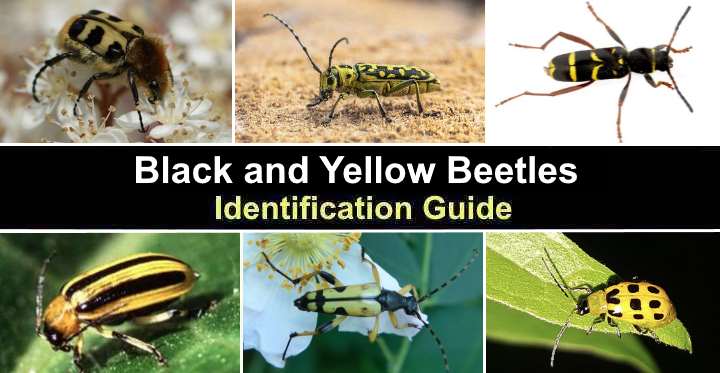
Black and yellow beetles are unusual insects due to their jet-black bodies with brightly colored yellow patterns. Beetles with yellow and black bodies are common in gardens, and you may find some small beetles in your home. Black and yellow longhorn beetles are harmless insects prevalent in yards throughout North America. Common black and yellow beetles in the house are larder beetles and ladybugs.
Although most black and yellow beetles don’t harm humans, some species can do tremendous damage to plants. For example, the black-spotted yellow cucumber beetle can eat the leaves of many crops in a vegetable patch. And black and yellow beetles like the locust borer and elm leaf beetle can damage young trees.
The good news is that many kinds of black and yellow beetles are beneficial insects. Therefore, if you see a few in your house or garden, you don’t need to worry about killing the insects. Many beetles feed on caterpillars and tiny household plant pests like aphids.
This article is a guide to identifying the most common varieties of black and yellow beetles. Descriptions and pictures of the yellow and black insects will help you recognize the beetle species.
Black and Yellow Beetle Identification
Black and yellow beetles are easily identified by their size, antennae, thorax, and general body shape. Identifying features may be yellow or black spots, stripes, or irregular markings on the elytra (wing covers). Like most insect species, black and yellow beetles have three pairs of legs and a pair of wings.
There are more than 400,000 species of beetle, many of which are black and yellow. All beetle species belong to the insect order Coleoptera. Individual species of black beetles with yellow markings are divided into families and genera.
Types of Black and Yellow Beetles (With Pictures) — Identification Guide
There are many types of black and yellow beetles. While most are beneficial insects, others can be nuisance pests in the house. Knowing their different features can help identify them correctly.
Here are pictures and descriptions of the most common species of black and yellow beetles.
Larder Beetles (Dermestes lardarius)
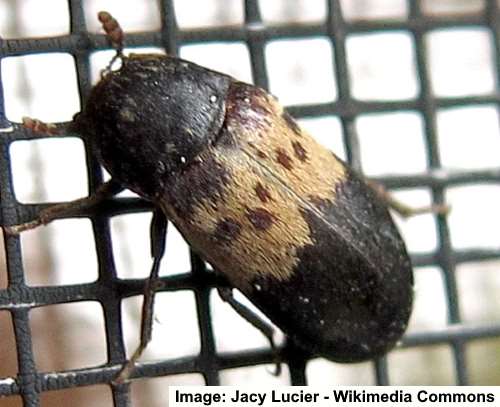
The small black larder beetle has a creamy-yellow band on the wing covers and feeds on dried foodstuff
A larder beetle is a type of black house beetle with a dull brownish-yellow band across its elytra. The tiny black beetles are identified by the three spots on the cream-colored or yellowish band on each wing case. Additionally, the house beetles have an oval body and stout club-tipped antennae.
Also called moisture beetles, larder beetles measure 0.33” to 0.37” (8 – 9.5 mm) and typically infest pantries. The tiny blackish beetles enter homes in spring and are attracted to cured meats, dry pet food, cheese, and dead animals. Unfortunately, their little black larvae can also damage books when they burrow into them, looking for protection.
The best way to get rid of larder beetles from your home is to store food in airtight containers. Additionally, it’s vital to clean all surfaces thoroughly in cupboards where you suspect larder beetles and their larvae or eggs were living. You can also kill larder beetles by freezing food for at least seven days.
Black and yellow beetle identification
Larder beetles are characterized by black bodies with a dull creamy, tan, or yellowish band across their wing cases and six spots.
Black and Yellow Longhorn Beetle (Typocerus sparsus)
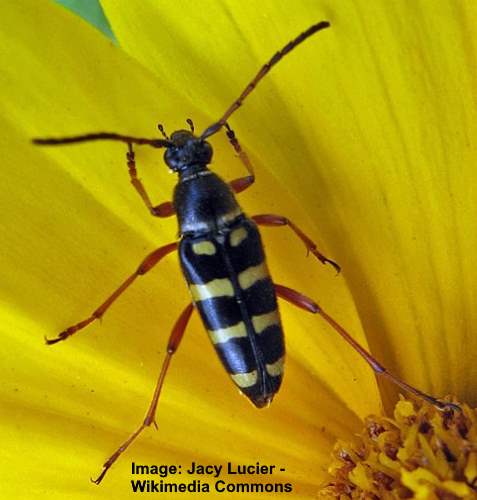
The black and yellow flower longhorn beetle has elongated body with long brown legs
Also called the flower longhorn, this black and yellow beetle has an elongated oval black body with yellow stripes across its elytra. The black and yellow beetle has long brown legs, a small head, and two long antennae. The slender, yellow-striped, black beetle resembles a tiny wasp when it flies.
The black and yellow longhorn beetle measures 0.43” (11 mm) and is common in wooded areas, parks, and grasslands throughout North America.
Longhorn beetles get their name from their long thread-like curved antennae. With the black and yellow longhorn beetle’s ability to fly, the flying insect mimics wasps as it feeds on nectar from spring flowers.
Black and yellow beetle identification
The black and yellow longhorn beetle is identified by the yellow stripes across its black elytra, long segmented antennae, and long brown legs.
Black and Yellow Spotted Longhorn Beetle (Rutpela maculata)
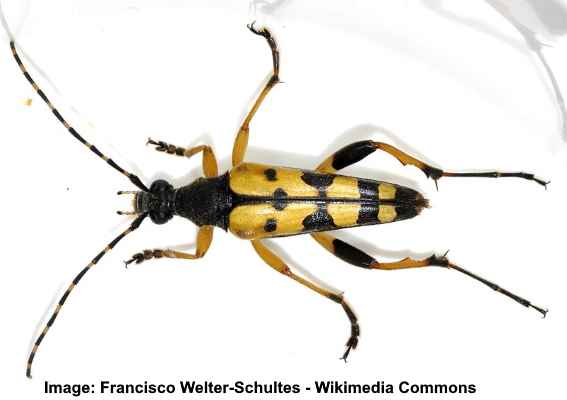
The black and yellow longhorn beetle is identified by its elongated body with black dots and stripes on its yellow body
The black and yellow spotted longhorn beetle is a medium-sized yellow beetle with black bands and spots on its elytra. Its distinguishing features include long yellow and black banded antennae, black and yellow legs, and an elongated triangular shape. Like many flying black and yellow beetles, this species mimics wasp behavior.
The spotted longhorn beetle measures 0.5” to 0.78” (13 – 22 mm) long. Like other species of longhorn, it has the characteristic of super-long antennae. Pictures of the yellow and black longhorn show it has a black head and pronotum, bulging eyes, and its yellow hind legs have a black band near the body.
Black and yellow spotted longhorn beetles are active from May through August, commonly found feeding on flower pollen and nectar.
Black and yellow beetle identification
The black and yellow spotted longhorn beetle is identified by its yellow body with black markings, head and thorax, banded antennae, and yellow and black legs.
Yellow-Horned Flower Longhorn Beetle (Strangalia luteicornis)
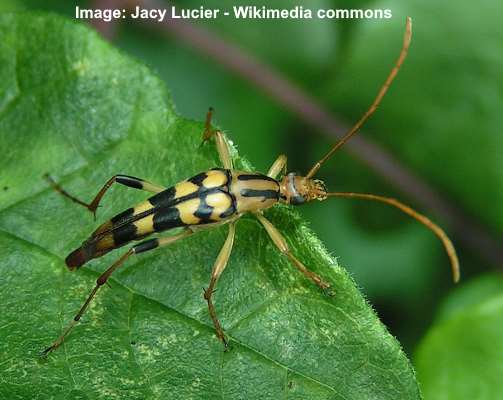
The slender body of the yellow-horned flower longhorn beetle is covered with black stripes
The yellow-horned flower longhorn beetle is a slender black and yellow beetle with an elongated body that tapers to a point. With its yellow and black zebra-like stripes, this beetle has dull, greenish-yellow legs, long arching antennae, and a small brownish head. There are also two black lengthwise stripes on its thorax.
The yellow-horned flower longhorn beetle measures 0.35” to 0.55” (9 – 14 mm) long. Its distinctive narrow body shape helps distinguish it from other black and yellow beetles.
You will find the yellow-horned flower beetle active during spring and early summer during the day. The yellow and black horned beetle is attracted to blooming flowers such as dandelion, clover, sunflower, and daisy.
Black and yellow beetle identification
This yellow-horned flower longhorn beetle is characterized by its bright yellow elytra with black markings, long curving yellow horn-like antennae, and greenish-yellow legs.
Cucumber Beetles
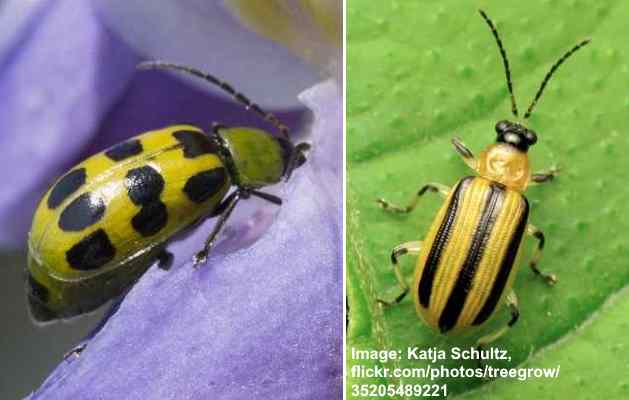
Cucumber beetles: In the picture: Spotted cucumber beetle (left) and striped cucumber beetle (right)
Cucumber beetles are distinctive yellow insects with black markings on their elytra. The two species of cucumber beetles are the striped cucumber beetle (Acalymma vittatum) and the spotted cucumber beetle (Diabrotica undecimpunctata). The rounded, oval, black and yellow beetles feed on crops like cucumber, eggplants, beans, and squash.
Cucumber beetles are hard to spot because they are tiny and spend most of their time under leaves. The first signs of a cucumber beetle infestation are usually holes in leaves and poor plant growth.
Striped cucumber beetle (Acalymma vittatum): This small oval beetle has brightly colored yellow elytra with three black stripes running lengthwise. The black and yellow beetle has a black head and antennae, yellow thorax, and black-banded yellowish legs. The tiny stripy yellow beetle measures 0.2” (5 mm) long.
Spotted cucumber beetle (Diabrotica undecimpunctata): This brightly-colored golden yellow beetle is identified by rows of large black dots on its wing covers. The oval rounded “bug” has a greenish-yellow thorax, black head, and segmented antennae. This plant-destroying insect looks like a yellow ladybug. The black-spotted yellow beetle measures 0.25” (6 mm).
Black and yellow beetle identification
Cucumber beetles are small yellow beetles with black markings on their elytra that are either spots or stripes.
Saperda scalaris
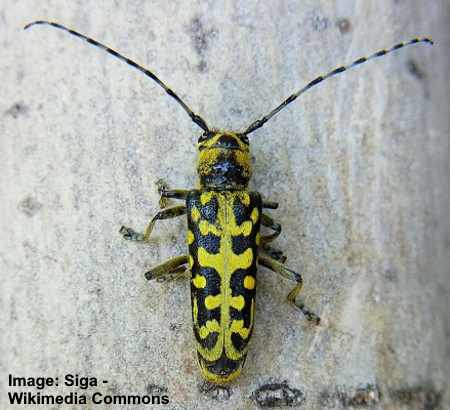
Saperda scalaris longhorn beetle has black and yellow markings covering its elongated body and long antennae
Saperda scalaris is a type of longhorn beetle with distinctive greenish-yellow and black markings covering its elytra. This slender yellowish-black beetle has an elongated body with a head the same width as the thorax. In addition, the small cylindrical beetle has dark greenish legs and banded antennae.
As with all species of longhorn beetles, Saperda scalaris has long, arching antennae almost as long as its slender body.
Black and yellow beetle identification
The Saperda scalaris is a yellowish-green beetle with wave-like black bands the length of its wing covers.
Eurasian Bee Beetle (Trichius fasciatus)
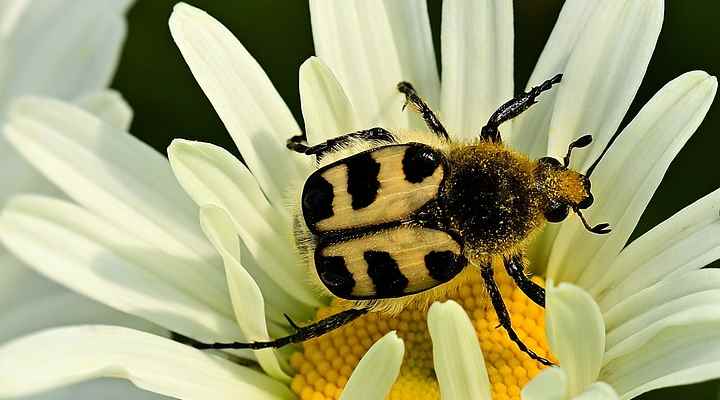
The Eurasian bee beetle is identified by its pale yellow body with black patches and short antennae
The Eurasian bee beetle is a stout, rounded black and yellow beetle that looks like a bumblebee. The identifying markings of this unusual beetle are its pair of yellow oval elytra with three large black dots, a fuzzy thorax, large eyes, and short clubbed antennae. In addition, the bee-like beetle has glossy black legs.
The Eurasian bee beetle is a small black and yellow beetle measuring 0.39” (10 mm) long. A feature of this strange beetle is the line of fine white hairs around its wing covers. The adult beetles are often found feeding on various flowers throughout summer — making them easy to confuse with bumblebees.
Black and yellow beetle identification
The Eurasian bee beetle can be easily distinguished by yellow and black wing covers surrounded by fine white hairs and its black head covered in yellowish setae.
22-Spot Ladybug (Psyllobora vigintiduopunctata)
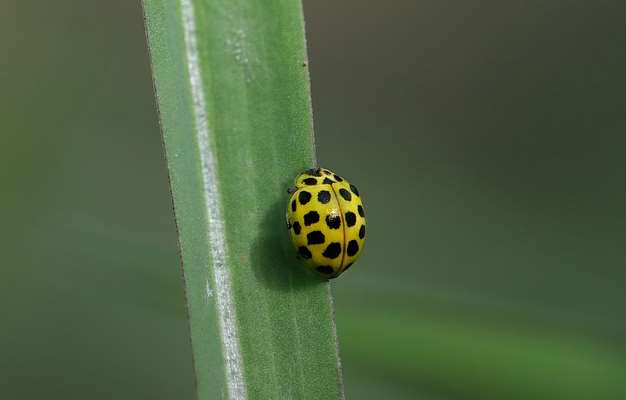
The tiny 22-spot ladybird has a yellow rounded body with black spots
The 22-spot ladybird is a striking beetle because of its domed shape and bright yellow color with contrasting jet-black spots. There are 11 spots on each of this tiny beetle’s yellow wing cases. Also, it has a yellowish pronotum with five black spots and a black head.
As one of the smaller species of ladybugs in the Coccinellidae family, the 22-spot ladybug measures only 0.19” (5 mm) long. The tiny, black-spotted yellow ladybug is found on low-growing shrubs feeding on mildew. Unlike other species of ladybugs that feed on aphids, this species tends to avoid eating bugs.
Black and yellow beetle identification
The 22-spot ladybug is easily identifiable by its bright glossy yellow domed wing cases with black spots.
Bamboo Borer / Bamboo Tiger Longicorn (Chlorophorus Annularis)
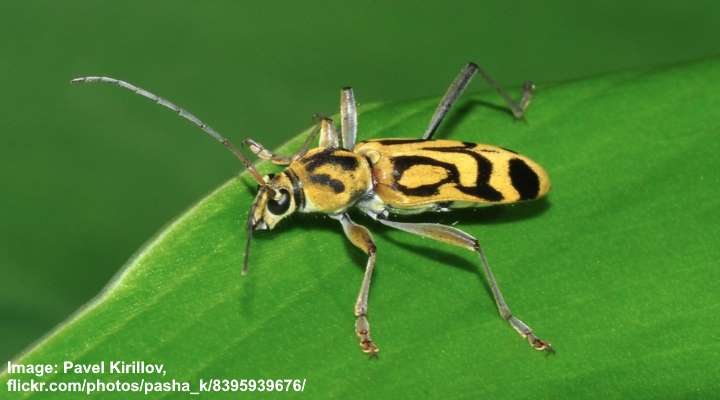
The bamboo borer is identified by its yellow body and irregular black pattern, long legs and long antennae
The bamboo borer is a small black and yellow beetle with irregular tiger markings on its slender elytra. The distinctive features of the bamboo borer beetle are its long, curved antennae, long legs, and two round black eyes on the side of its head. The small, elongated beetles measure 0.6” (15 mm) long.
As its name implies, the bamboo tiger longhorn beetle feeds on various plants in the Bambusa genus. However, it will also feed on sugarcane and sweetgum. In addition, the beetle has a distinctive tiger-like pattern on its back and two long antennae.
Black and yellow beetle identification
The bamboo tiger longhorn beetle is easily recognizable from other longhorn beetles due to its unusual yellow and black patterns on its wing cases.
Yellow-Bellied Beetle (Pachnoda flaviventris)
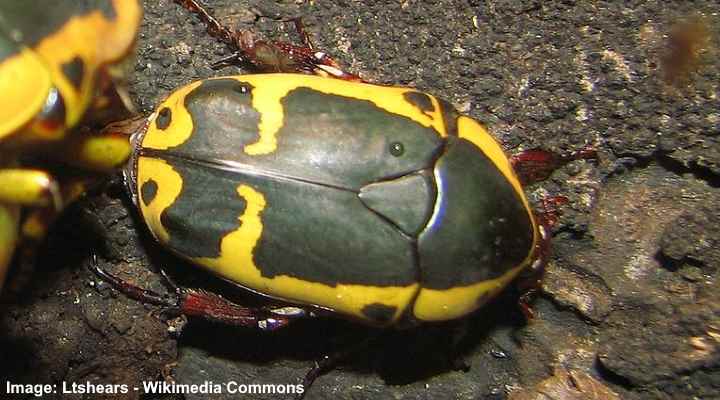
The yellow-bellied beetle has an oval yellow and black body with brown head and legs
The yellow-bellied beetle is a broadly oval flying beetle with a large black patch and two black dots on its bright yellow elytra and pronotum. The stout yellow and black beetle has robust legs that are a deep brown-red color and a reddish-brown head with short, clubbed antennae.
Also called the garden fruit chafer, the yellow-bellied beetle measures 0.79” to 2” (20 – 25 mm). Although the beetle is primarily yellow and black on the upper side, its underside reveals a brightly colored yellow body. Garden chafers are typically found feeding on fruit during the summer.
Black and yellow beetle identification
The brightly colored yellow-bellied beetle is identified by its flattened oval elytra that are mainly black with yellow margins. Additionally, it has dark reddish-brown antennae, heads, and legs.
Fiddler Beetle (Eupoecila australasiae)
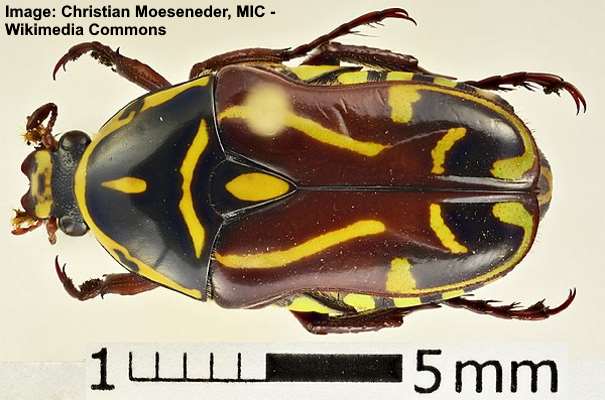
The fiddler beetle has oval flattened black and brown body with yellow markings and short legs
The fiddler beetle or rose chafer is a colorful yellow and black scarab beetle with a distinctive violin pattern on its dark brownish or black elytra. Additionally, the beetle features a sizable rounded pronotum, small black head, and stout clubbed antennae. The large black beetle with its curved yellow markings measures 0.6” to 0.8” (15 – 20 mm).
The smooth-bodied black and yellow fiddler beetles feed on flower nectar. As a result, they are often seen flying from flower to flower, playing a crucial role in flower pollination.
Some pictures of rose chafer beetles show them to have dark brown wing covers with neon-green markings.
Black and yellow beetle identification
The fiddler beetle is identified by its dark brown to black flattened oval body with brightly-colored yellow markings, spiny brown legs, and conspicuous large eyes on the side of its head.
Wasp Beetle (Clytus arietis)
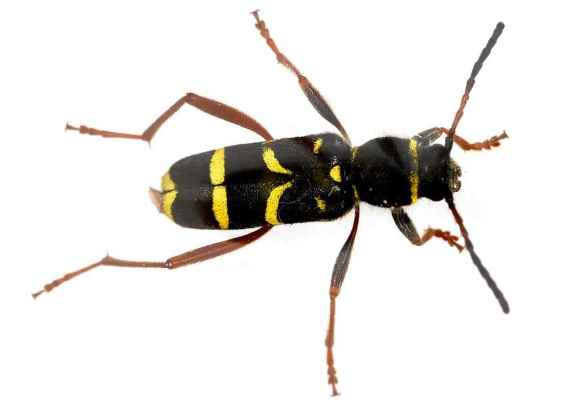
The black and yellow wasp beetle has a slender body and is an important pollinator
The wasp beetle is an unusual species because it looks like a yellow-striped wasp. This slender black beetle has two yellow bands across its back, a yellow patch at its tail, and a small yellow dot behind the thorax. Other distinguishing features of this wasp mimic are its brown legs, banded thread-like antennae, and a small head.
The black and yellow wasp beetle measures 0.35” to 0.71” (9 – 18 mm) long. Like wasps, the beetle feeds on nectar and pollen on summer-flowering plants. However, unlike wasps, this beetle species is harmless and has no stinger.
Black and yellow beetle identification
The distinctive characteristics of the wasp beetle are its slim black body and brightly-colored yellow stripes across its elytra.
American Carrion Beetle (Necrophila americana)
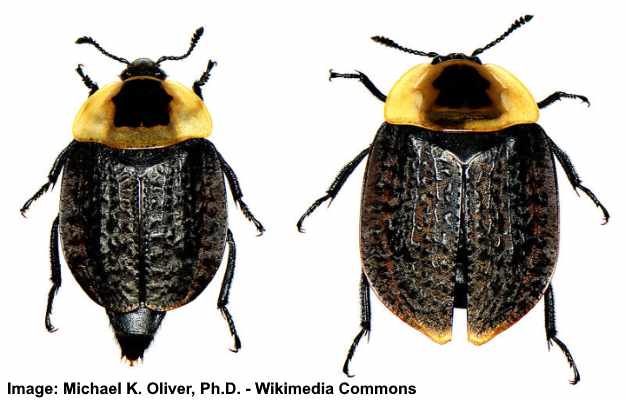
In the picture: American carrion male beetle (left) and female (right)
The American carrion beetle is a distinctive beetle with a broadly oval black shape and a pale yellow pronotum. Pictures of the black and yellow beetle show its elytra have a bumpy texture and its yellow shoulder area has a dark brown patch behind its head. The antennae on this carrion beetle are capitate shaped.
The American carrion beetle measures 0.51” to 0.86” (13 – 22 mm) long. Sometimes, the flying beetle is mistaken for a flattened bumblebee or fat firefly.
These black and yellow beetles have an essential role in the ecosystem. The black beetles feed on dead and decaying organic matter, muscle tissue, and flesh. They are typically found under rocks or near rotting food or animal carcasses.
Black and yellow beetle identification
The black American carrion beetle has a bumpy black elytra with a bright yellow thorax and shield-shaped dark brown or black mark in the middle.
Locust Borer (Megacyllene robiniae)
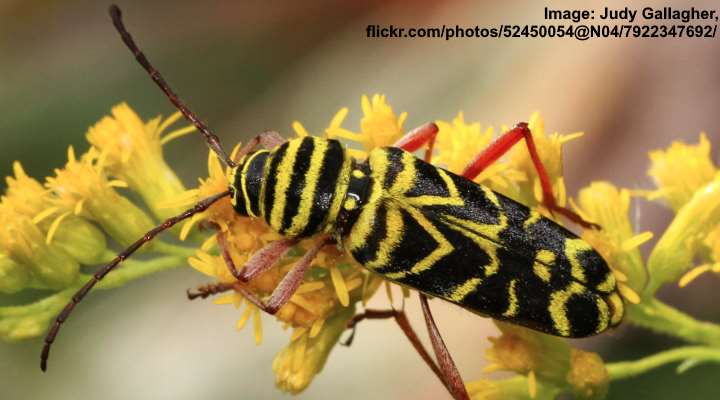
The slender body of the locust borer is covered with black and yellow stripes and zig-zag markings
The locust borer is a black and yellow beetle that is easy to mistake for a wasp. The colorful beetle has a yellow zig-zag pattern on elongated black oval elytra. Its black thorax and head have yellow horizontal stripes. In addition, it has curved thread-like dark brown antennae and brown-orange legs.
The adult locust borer beetles measure 0.42” to 1” (11 – 28 mm) long. The locust borer is a black and yellow beetle native to North America. The flying beetles are common where black locust trees and goldenrod plants grow.
Black and yellow beetle identification
The slender, slightly fuzzy locust borer beetles have a stripy appearance with a distinctive yellow ‘W’ shape on their elytra. It also has several yellow stripes traversing its head, thorax, and wing covers.
Elm Leaf Beetles (Xanthogaleruca luteola)
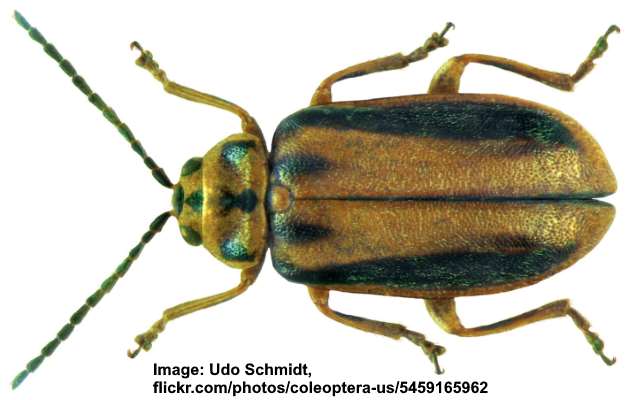
The dark yellow elm leaf beetle has dark green to black markings with metallic undertone
The elm leaf beetle is a non-native dark yellow beetle with a coffee-bean shape. The stout beetle has metallic golden yellow elytra, head, and thorax with iridescent green, almost black markings. The deep yellow wing covers have dark green markings, and the thorax has an hourglass marking with a greenish dot on either side.
The small yellow and dark green beetle measures 0.23” to 0.31” (6 – 8 mm) long. The invasive dark yellow beetle is widespread throughout North America, where the adult beetles and larvae can decimate the foliage of elm trees.
The pesky beetles can also become pests in the home if you have several elm trees nearby. This is because the flying beetles are attracted to lights when it gets dark.
Black and yellow beetle identification
The elm leaf beetle is a golden yellow beetle with dark green to black markings and a metallic sheen.
Related articles:
